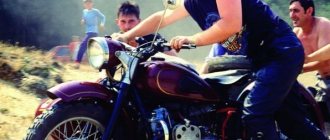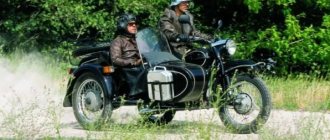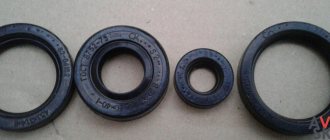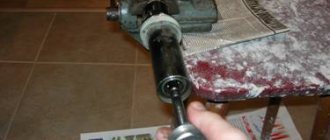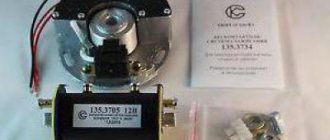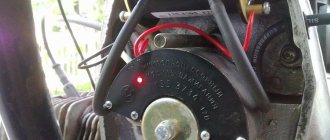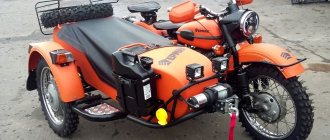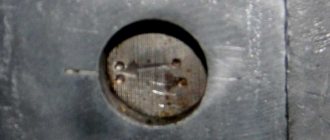content .. 41 42 46 ..
Front fork of Ural motorcycle
IMZ-8.103-10
The telescopic front fork with internal springs and a double-acting hydraulic shock absorber (Fig. 22) consists of a steering column rod 8 with a bridge 16, a yoke 3, two stays with shock absorbers and a steering shock absorber (damper).
The steering column rod serves to attach the fork to the frame head on two support ball bearings. The lower end of the rod is pressed into the bridge, and its upper end is clamped in the frame head with a nut that tightens the bearings.
The crossbar is placed on top of the conical ends of the pipes of 24 fork legs and is attached to the rod with a nut. The fork leg tubes are inserted into the two side split holes of the bridge and secured with coupling bolts.
The fork spring softens shocks transmitted from the wheel to the frame. The lower end of the spring is screwed onto the nut 35 of the shock absorber tube, the upper end is screwed onto the upper tip 12 of the spring, placed on the rod, between the limit nuts. The spring connects the movable part of the fork (tip 25 of the fork leg) and the fixed pipe 24 of the fork leg and can work in both compression and tension.
An oil shock absorber is installed in each front fork leg to dampen vibrations. It consists of a tube 27, a rod 34, a tube nut 35 and a lower shock absorber guide 31. The tip 25 of the pen is filled with oil, the level of which should be above the lower guide. .
The shock absorber body is secured with a bolt 29 to the base of the fork leg tip. There are holes at the bottom of the shock absorber housing to allow oil to pass into the shock absorber.
The upper end of the rod is screwed into the tightening nut 11 of the feather tube. The lower shock absorber guide 31, which has the shape of a square with rounded corners, is attached to the rod from below with a nut. Above the guide there is a shock absorber piston 32, made in the form of a plate with a hole in the center. The edges of the piston fit tightly to the inner surface of the shock absorber tubes. The upward movement of the piston is limited by pin 26. At the moment when the piston rests against the pin, oil passes freely from bottom to top through the gap between the piston hole and the rod.
Nut 35 of the shock absorber tube serves as the upper guide of the rod and is a glass with a calibrated hole. The shock absorber body moves with the wheel axle.
135 cm3 of engine oil is poured into each fork leg through unscrewed tightening nuts 11. To remove oil and wash the fork legs, you need to unscrew and remove the tips (see section 9, page 89).
When assembling the front fork, it is necessary to ensure that there is a gap of 0.2-0.5 mm between the tips of the spring and the nut that locks the tightening nut of the airfoil tube, ensuring free rotation of the tightening nut with the rod.
Steering shock absorber. The motorcycle is equipped with a friction-type shock absorber (see Fig. 22). It consists of two steel washers, movable 37 and fixed 39, two friction washers 17 and a tightening bolt 7 with a head. Friction between the steel and friction washers makes the front fork difficult to turn.
The degree of tightening of the steering damper is selected depending on the road condition and driving speed. When driving at high speed, especially on uneven roads, the tightening bolt must be tightened; When driving slowly or with frequent turns, the bolt is released, since a tightly tightened shock absorber makes it difficult to turn the steering wheel.
The bearing tightening must be adjusted in the following sequence:
hang the front part of the motorcycle so that the front wheel does not touch the ground;
Unscrew the tightening bolt of the steering shock absorber, remove the spring and support washer, supporting the shock absorber washers with your hand;
by rocking the front fork (up and down) by the handlebars or by the tips of the stays, determine the presence of play.
If there is play in the bearings, you need to loosen the nut 4 of the steering column rod, move up the yoke 3 with the nut, having first loosened the tightening nuts of the fork legs, tighten the nut 9 of the bearings until it stops, and then loosen 1/6-1/8 of a turn. Check again for play in the bearings.
Rice. 22. Front fork: 1 — protective washer; 2 - oil seal;. 3 - traverse; 4 — steering column rod nut; 5 — support washer; 6 — spring washer; 7 — long bolt; 8 — steering column rod; 9 — bearing nut; 10 — upper angular contact ball bearing; 11 — tightening nut; 12 — upper spring tip; 13 — casing sealing ring; 14 — feather casing with headlight bracket; 15 — coupling bolt; 16 — steering column bridge; 17 — friction washers; 18— spring; 19— oil seal cuff; 20 — oil seal cuff; 21 — oil seal spring; 22 — opera ring; 23 — upper bushing; 24 — fork leg pipe; 25 — tip of the fork; 26 - pin; 27 — shock absorber body tube; 28 — shock absorber housing cone; 29 — shock absorber mounting bolt; 30— lower bushing; 31 — lower shock absorber guide; 32 — shock absorber piston; 33 — spring ring; 34 — shock absorber rod; 35 — shock absorber tube nut; 36 — oil seal housing; 37 — movable washer; 38 — lower angular contact ball bearing; 39— stationary washer of the steering shock absorber; 40 — head frame pipe; A - sub-piston cavity; B - supra-piston cavity
content .. 41 42 46 ..
Motorcycles Ural and Dnepr
Nikita_Belousov
Guys!
Tell me what kind of front fork (preferably the “inverted” type) to install on the “Dnepr 11” with minimal modifications to both the motorcycle itself and the fork??? sam
Buy Izhevsk pneumatics, crossbars can be bought at Aviamotorka, then you don’t need to do anything at all.
yurg
and I would advise you to leave the original one, but replace the springs with Izhevsk ones.
Wong
If it is possible to find a fork from a Japanese company, then I can recommend the “upside-down” fork from the GSX-R 400 (750, 1100).
A very distinguished fork. Among the classic “telescopes”, the fork from the CBR 900RR has proven itself very well (this one is now in Kamikaze (Moscow)). It is best to take the fork assembled with the front wheel, calipers and brake discs, so that later there is no hassle with fitting and selection. If it’s simpler and cheaper, then, indeed, the Izhevsk fork with homemade grammatical traverses from al. alloy will do. Nikita_Belousov
Can you tell me where to get the drawings of the traverse for the Izhevsk fork???
referenced
quote: Can you tell me where to get the drawings of the traverse for the Izhevsk fork???
here and take it, in -DRAWINGS-…
sam
quote:
here and take it, in -DRAWINGS-...
So as not to search for a long time https://oppozit.ru/modules.php?name=Downloads&d_op=getit&lid=2
Nikita_Belousov
Thank you all!!! How much would it cost to turn this kind of part???
I found a pneumatic fork from IZH with a steering wheel and a wheel for 400 rubles, but without a disc brake (with a drum brake) is this normal (in terms of price) or not???
Wong
, by the way, you can change the drawings to your liking.
The only thing you need to adhere to is the size of the holes for the fork legs. Nikita_Belousov
In general, I’ll describe what I want: an Izha fork (well, so that the wheel has a thick NOT moving part, and the steering wheel has a thin part) with a front disc brake and wheel!!! Where can I buy this in St. Petersburg or Moscow??
What is an Orion fork???
Wong
quote:
What is an Orion fork???
This is exactly what you described.
manowar
only this is not a changeling….
Nikita_Belousov
So WHERE to buy?????
And please tell me the approximate price……. HammerFall
Is faith over 2600 normal in falconers?
beard_
for Nikita_Belousov
:
I would advise you to get along with these guys: Night Riders Karelia, Petrozavodsk, st.
Birch Alley, 25–19, t.: (8142)756–158 pomah
Off topic: Nikita, you are my namesake.
: ) marlboro
for HammerFall
:
In general, the name is written with a capital letter
Nikita_Belousov
Thank you all... (Especially poma))) for the useful information...
But this is the situation: there is a guy I know at the car market, so he promised to bring this plug from Moscow or St. Petersburg with a minimal markup, but I have to find it myself. I only have the INTERNET and it’s advisable to find a price list with such a plug on the INTERNET itself...
I haven’t succeeded yet. Someone tell me plz
Nikita_Belousov
And what kind of tires to put (from foreign “cool” asphalt ones up to 1500 rubles) on 19-inch original wheels???
Wong
Up to RUB 1,500? I don't think there are any like that. At a minimum, you should expect a price of 70-80 US dollars.
MY MOTORCYCLE
A lever fork is one of the main attributes of any stroller, and certainly a shit climber can’t do without it. For example, in the West, people generally cannot imagine a motorcycle with a sidecar equipped with a telescopic fork - for them the lever is the first gadget that needs to be installed on the sidecar alone.
Of course, I’m not a designer, and I don’t have any special knowledge. This article is written from the perspective of an ordinary person, and may contain many erroneous ideas. The “drawings” given here are also probably not drawn very correctly, but if anyone is interested, then in the future I can post a 3D model of the product in 3dm Rhinoceros format. I’ll say right away that the fork was originally made with a very critical error, as a result of which it broke at the most inopportune moment. This led to an accident, but fortunately no one was injured. I'll talk about this at the very end of the article.
So, making a lever fork is the easiest way to get a durable, long-travel motorcycle fork. However, despite the apparent simplicity of its design, I personally encountered unexpected difficulties, which, however, I was able to overcome after understanding their cause.
A friend gave me 2 ready-made feathers and a pendulum blank, and I started from these details when developing my product.
My tasks were as follows:
- Increase ride comfort over uneven surfaces;
- Raise the front of the motorcycle as much as possible. This was required to increase clearance;
- Reduce the overhang (trail) to the minimum acceptable value in order to facilitate steering both on bad roads and on asphalt;
Based on these tasks, using CAD, I quickly made a model of the fork along with the motorcycle frame, checked everything, and made a swingarm from a round pipe. But this pendulum did not satisfy me with its low rigidity, so I threw it away. I had to redraw the project and weld a new pendulum from a St-3 25x40x2 profile pipe. This pendulum turned out to be very rigid. The only place in it that requires explanation is the bushings for the wheel axle. The bushings are solid, steel, and the axle is simply passed through them and secured with a nut. The wheel and brake drum are secured against axial displacement by a spacer sleeve. The axle play is eliminated using brass bushings that I made from 12 gauge brass sleeve.
I assembled the pendulum in a certain order. First the end tubular sections were cut out, then I welded the bushings to them. After this, the welding points between the bushings and the pendulum were reinforced with side plates, welded in a circle. Then, having threaded the axle through the bushings, I welded the main sections of the pendulum to the end sections. The next step is welding the shock absorber mounting ears. In the end, I realized that it was easier to install the ears on a fully assembled swingarm, and welded the rear bridge to it. It was then that I encountered the problem of the product moving away during welding, but I easily straightened the bent pendulum using a jack. Then I installed reinforcing pads under the ears for attaching the feathers, and then the ears themselves. Next, it remained to install the gussets on the connections of the pendulum jumper, and I did this, spreading its ends with a jack so that it would not move away. All ears should be welded by passing a pin through them to control the location of all parts; It is convenient to measure the size from the inserted wheel axle.
Next, I installed the upper shock absorber mounting lugs on the stays, and my fork, in general terms, was ready for fitting. I decided to install silent blocks in the bushings of the feathers, but I couldn’t find anything suitable in auto stores. Silents had to be made from scrap materials: the rubber bushing of the passenger footrest was ideal, and steel bushings with an internal diameter of 12 mm were found on the farm. The wheel axle was made from the rear wheel axle, the “thick” part of which had to be ground 30mm so that the long narrow part, 20mm in diameter, would fit through both bushings.
Now I must say a few words about shock absorbers. Initially, I lengthened the standard Ural shock absorbers, and replaced the “native” mount with a silent block. A silent block on a tube leg was attached to the body by welding. I will not describe all my torment associated with selecting the optimal shock absorber length, but I will say right away that it is now 370mm. Subsequently, on one of these ancient KMZ products, my stem broke, and I replaced them with a Chinese analogue. I also welded tubes for silent blocks onto their lower mount. A little more time passed, and I replaced the Chinese dinners made from someone’s feces with old Soviet ones. From that moment on, everything became good, and I have been driving these shock absorbers for a year now without any problems.
The reaction rod of the brake shield is attached to the pendulum. On the one hand, this solution seems good to me, since it does not require any additional tricks. Usually the rod is attached to the feather, and this necessitates allowing the shield to swing relative to the pendulum. In my case, the shield always remains motionless and can be tightly clamped between the bushings of the pendulum and the hub. In general, the anti-dive of the fork is regulated by the location where the torque rod is attached. In my case, when braking, the motorcycle not only doesn’t bite, but on the contrary, it lifts its nose. That is, the force stretching the fork is too strong for me. But since I use standard, very sluggish brakes, I’m not worried about the health of the suspension. In practice, I have never experienced any “reverse breakdowns” in shock absorbers. If you attach the reaction rod a little higher, on the feather, you can ensure that the motorcycle does not receive any trim at all when braking.
So, I installed the entire structure on the motorcycle, figured out how the wing would be attached, and welded the corresponding ears to the feathers. Now the tests could begin.
At low speeds on a dirt road, the motorcycle behaved just fine, but as soon as I accelerated, I lost all control over the car, I began to wobble from side to side, as a result of which I almost rolled over. Obviously, this is how problems with the geometry of the fork manifested themselves, namely, with its offset, or trail. Through various observations, measurements, modeling and experiments, I realized that too weak shock absorber springs, as well as unadjusted rebound valves, were to blame. At low speeds, the shock absorbers at least managed to work out all the irregularities and return to their original state, but as the speed increased, they no longer coped with their job and were constantly in a semi-compressed state.
The fact is that a lever fork with a geometry like mine, when the pendulum rises on uneven surfaces, tends to greatly reduce the reach. With strong compression of the shock absorbers, it decreases to almost zero, and sometimes can reach negative values. Naturally, this causes loss of control of the motorcycle at high speed.
I solved the problem simply. It turned out to be sufficient to adjust the shock absorber valves and increase the spring preload to increase their stiffness. I tightened the springs by 15mm, placing spacer rings under them. 15mm was taken based on the fact that the shock absorbers sagged exactly by this amount when I sat on the motorcycle tank.
As I wrote above, this improvement led to a break in the rod of one of the shock absorbers: old Soviet shock absorbers, in fact, are almost impossible to adjust. They were replaced by the Chinese with good Soviet springs and the same spacer rings.
Not knowing grief, I traveled all winter, and then, in the spring, we went to the Smolensk region. It was then that trouble happened to us. On a very rough road, both forks broke, causing the motorcycle to overturn. At first we didn’t quite understand what had happened, since the fork did not fall apart, but after driving another 500 meters and flying into a ditch, we realized that something was wrong here.
And indeed, an autopsy showed that both “crowbars” were cracked along the groove that was made so that they would fit into the cross beams. The cause of the breakdown was obvious. A sharp step between two diameters served as a stress concentrator. Due to constant vibration and stress, mainly aimed at “bending” the feathers, cracks appeared on their back side. The chainstays straightened out, the trail became negative, and the motorcycle lost control.
All this could have been avoided if the transition from one diameter to another had been smooth. But ideally, cuttings were also needed, which would relieve the feathers. The broken fork was promptly welded, I also welded these same cuts from the fittings. After that, she traveled another thousand kilometers, and upon returning home, I immediately rushed to my friend, who helped me make this fork, to make new powerful feathers.
To make a completely indestructible fork, we welded feathers from “crowbars” from a standard Soviet “telescope”. One lever pen requires one and a half telescopic crowbars. They are connected using bushes secured with electric rivets. Next, the connection is scalded. We retained the original geometry. The difference with the old feathers was the absence of any grooves and the presence of bevels made from pipes. Since the lower traverse is located inside the resulting diamond, it is not removable. That is, the fork can no longer be completely disassembled - the lower yoke is movable, but it will remain with the fork forever.
After this improvement, any problems disappeared, and since then I have been driving without fear.
Source: www.sevprostor.ru
